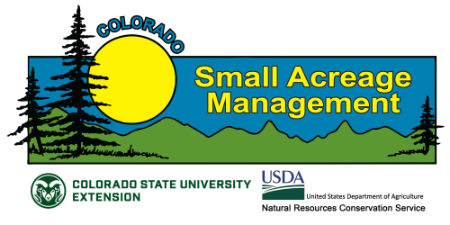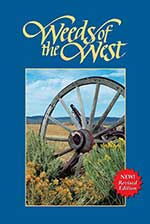What are Weeds
What are weeds?
- a plant out of place and not intentionally sown
- a plant growing where it is not wanted
- a plant whose virtues have not yet been discovered (R.W.Emerson)
- plants that are competitive, persistent, and interfere negatively with human activity or management
We can say that weeds are plants whose undesirable qualities outweigh their good points. In the US, crop losses and weed control programs are in the tens of billions of dollars each year.
Weeds are naturally strong competitors and those weeds that can best compete always tend to dominate. We may breed plants for yield, while nature breeds plants for survival. (D. Ligenfelter)
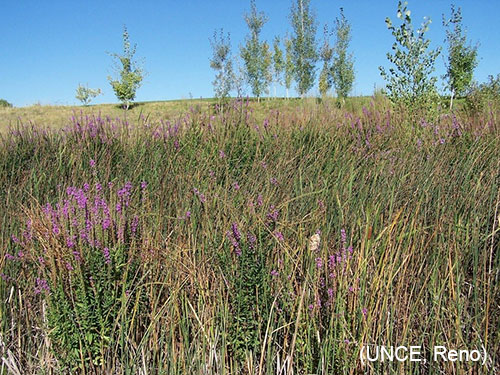
Weeds are excellent competitors for resources. This photo shows purple loosestrife invasion into a dense wetland area.
What are noxious weeds?
Noxious weeds are non-native plants that disrupt native vegetation because they have no natural controls and are able to adapt to varied climate conditions. As a result of the Colorado Noxious Weed Act, noxious weeds have been categorized according to their status: A, B, and C.
List A Plants: Eliminated everywhere
List B Plants: Spread should be stopped
List C Plants: Control is recommended
Watch List: Early identification of potentially harmful plants
Pocket Guide
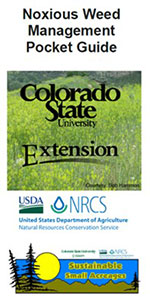
Noxious Weed Management Pocket Guide
Easy to print and carry; provides information to identify and help manage some of the common weeds for Colorado. Click to download your area specific guide.
- Chaffee County
- Delta County
- Eagle County
- Elbert County
- Garfield County
- Gunnison County
- Las Animas County
- Lincoln County
- Mesa County
- Moffat County
- Montezuma County
- Montrose County
- Rio Blanco County
- Routt County
- Teller County
- Teller-Park Conservation District
- Sawpit
- Statewide
- Tri River Area
- Pitkin County
Control
How can I control weeds on my property?
- Identify your weeds
• Know exactly what it is you want to control.
• Determine the species – use ID guides or consult your local professional - Learn about the “ENEMY”
• Know the weed’s life cycle
• Determine the best time to attack the plants - Understand control methods
• Know preventative, cultural, mechanical, chemical, and biological
control options.
• Determine the appropriate control method for your specific weeds. - Develop a management plan
• Know how to monitor and evaluate your property
• Determine how to treat your land, be persistent and adaptive
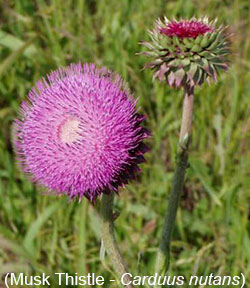
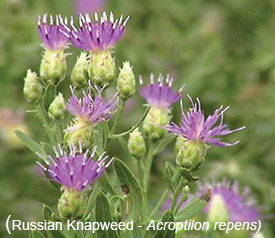
Determine the Appropriate Weed Control Method for your property
Effective control depends on persistence and an integrated approach utilizing a combination of all the available methods.
Preventive:
The first and the most important step in a weed control program. Probably the most cost-effective method of weed control. Methods include: maintaining healthy pastures, using weed-free crop seed, weed-free manure and hay, and clean harvesting and tillage equipment, as well as the elimination of weed infestations in areas bordering cropland, and in irrigation ditches and canals.
Cultural:
Methods include: Establishing and managing an adequate population of desirable vegetation to compete with the weeds; utilizing livestock (cattle, goats, sheep) when possible; mulching; burning; and even plastic weed barriers.
Mechanical:
Methods include: Hand-pull, hoe, mow and tillage.
Biological:
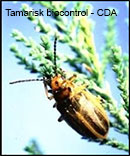 Biological weed control involves the utilization of natural enemies for the control of specific weed species. Likely not 100% effective method of control, and can take many years for success. Methods include: grazing, introduction of registered insects or diseases. Contact the Palisade Insectory for more info.
Biological weed control involves the utilization of natural enemies for the control of specific weed species. Likely not 100% effective method of control, and can take many years for success. Methods include: grazing, introduction of registered insects or diseases. Contact the Palisade Insectory for more info.
Chemical:
Always read the label before using any herbicide! Weed control with herbicides is an effective tool for many target weed species. However, there are several aspects to consider when choosing a chemical program. These include: ID of target weed; herbicide selection; timing of application; desirable crops or plant species near control areas; the number of applications per year, and the number of years for treatment.
Always add a nonionic surfactant @ 0.32 oz/ gal (1qt/100 gal) unless otherwise noted.
Take a look at the Sprayer Calibration Fundamentals factsheet to ensure you are applying your herbicides appropriately.
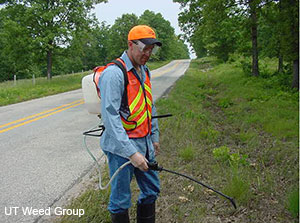
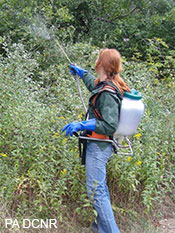
-
- Remember,
THE LABEL IS THE LAW!
-
- Always read and adhere to all instructions on the label.
Targeted Weed Control Using Livestock: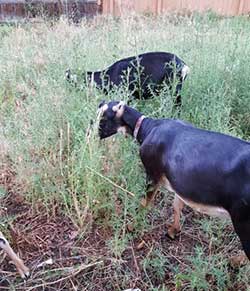
- Targeted grazing: A natural approach to vegetation management and landscape enhancement. American Sheep Industry Association.
Resources
Resources & Helpful Information
SAM Webinars and Web Videos
- Biological Weed Control for Colorado Landowners
- Understanding Weeds
- Integrated Weed Management
- Planning for a Sustainable Homestead
• Guide to Planning on Your Property - How Weeds Grow – short videos on how weeds grow
• Part 1
• Part 2 - Using Bindweed Gall Mites to Manage Field Bindweed – 3 minute video about biological control of bindweed
- Tractor Sprayer Calibration – 10 minute video from PSU on the easy way to calibration
- Calibrate a Backpack Sprayer – 8 minute video from PSU on backpack sprayer calibration methods
SAM Newsletter Articles
- Annual Weeds – spring 2021
- A Website We Love – summer 2020
- Fall Weed Management – fall 2019
- Canada Thistle Rust – summer 2019
- Weeds With Taproots: Organic Control on Small Plots
- The Spreading of Weeds – winter 2019
- Canada Thistle and Field Bindweed – summer 2016
- Hiring a Weed Control Contractor – summer 2016
- Understanding and Using “cides” – spring 2016
- Reading Pesticide Labels – spring 2016
- Pollinator Protection – What’s Your Role? – winter 2016
- Canada Thistle – fall 2015
- Weed ID and Control – summer 2015
- Western Whorled Milkweed Poisoning – winter 2015
- Noxious Weeds: Fall Control – fall 2014
- Goats for Weed Control – summer 2014
- A Promising Control for Canada Thistle – winter 2014
- Thistles – summer 2013
- How to Read a Pesticide Label – summer 2013
- Facts About Dalmation Toadflax – spring 2013
- Palisade Insectary offers Biocontrol Options – summer 2012
- Weeds Are Impacting Our Landscape – winter 2012
- Facts About Purple Loosestrife – summer 2011
- Facts About Diffuse Knapweed – spring 2011
- Early Weed Detection for Better Management – winter 2011
- Facts About Scotch Thistle – fall 2010
- Use “weedy” Natives to Fight Noxious Weeds – summer 2010
- Toxic Weeds and Horses – spring 2010
- Friend or Foe? – winter 2010
- What’s In Your Garden: Weed or Wonderful? – summer 2009
- Leafy Spurge: A Colorado Noxious Weed – spring 2009
- The Impact of Weeds – spring 2009
CSU Extension Fact Sheets
Additional Resources
Brief interview – Goats Grazing Weeds in CO
THE LABEL IS THE LAW
If you have lost a label, or can not read the instructions, type the product name into the Agrain Label Search Tool:
